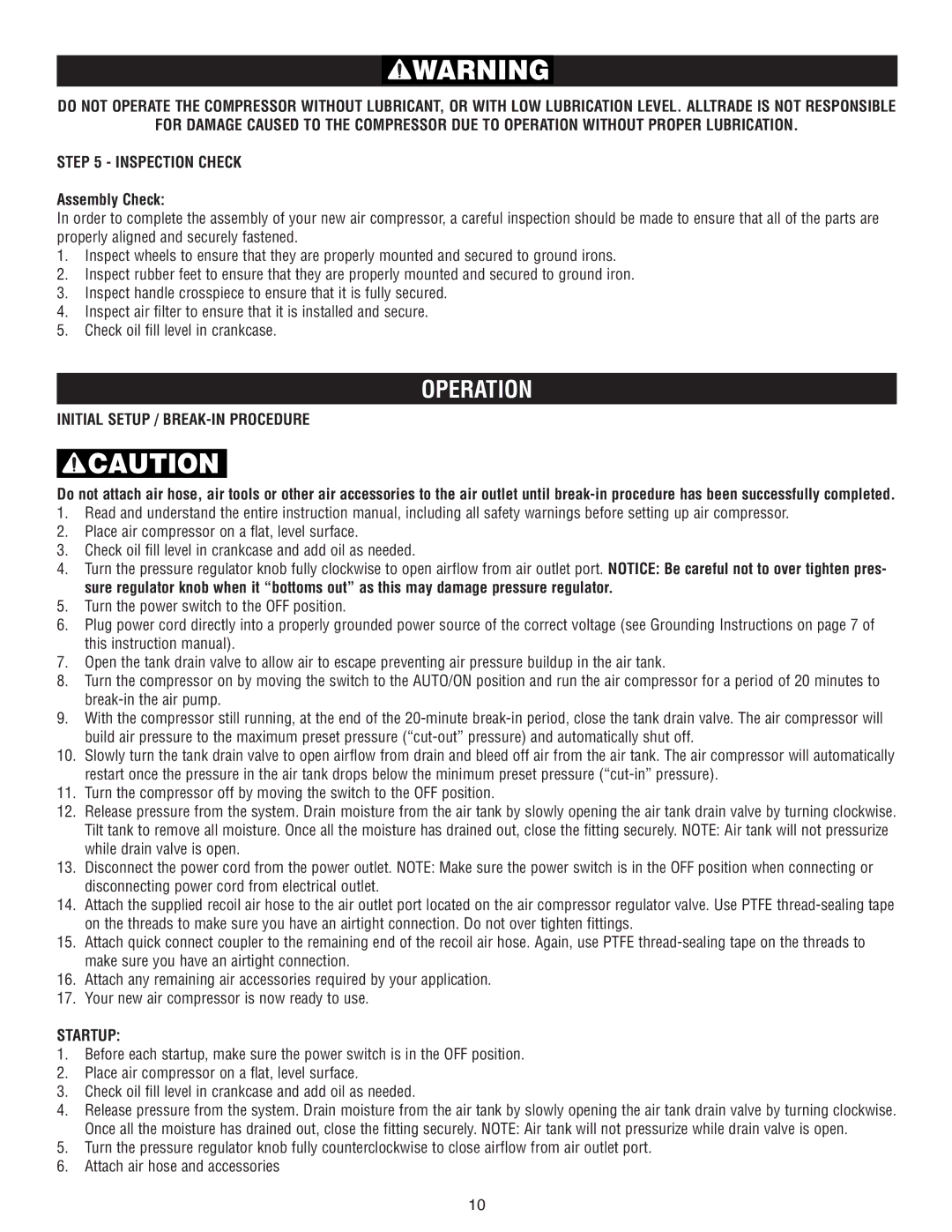
![]() WARNING
WARNING
DO NOT OPERATE THE COMPRESSOR WITHOUT LUBRICANT, OR WITH LOW LUBRICATION LEVEL. ALLTRADE IS NOT RESPONSIBLE
FOR DAMAGE CAUSED TO THE COMPRESSOR DUE TO OPERATION WITHOUT PROPER LUBRICATION.
STEP 5 - INSPECTION CHECK
Assembly Check:
In order to complete the assembly of your new air compressor, a careful inspection should be made to ensure that all of the parts are properly aligned and securely fastened.
1.Inspect wheels to ensure that they are properly mounted and secured to ground irons.
2.Inspect rubber feet to ensure that they are properly mounted and secured to ground iron.
3.Inspect handle crosspiece to ensure that it is fully secured.
4.Inspect air filter to ensure that it is installed and secure.
5.Check oil fill level in crankcase.
OPERATION
INITIAL SETUP / BREAK-IN PROCEDURE
![]() CAUTION
CAUTION
Do not attach air hose, air tools or other air accessories to the air outlet until
1.Read and understand the entire instruction manual, including all safety warnings before setting up air compressor.
2.Place air compressor on a flat, level surface.
3.Check oil fill level in crankcase and add oil as needed.
4.Turn the pressure regulator knob fully clockwise to open airflow from air outlet port. NOTICE: Be careful not to over tighten pres- sure regulator knob when it “bottoms out” as this may damage pressure regulator.
5.Turn the power switch to the OFF position.
6.Plug power cord directly into a properly grounded power source of the correct voltage (see Grounding Instructions on page 7 of this instruction manual).
7.Open the tank drain valve to allow air to escape preventing air pressure buildup in the air tank.
8.Turn the compressor on by moving the switch to the AUTO/ON position and run the air compressor for a period of 20 minutes to
9.With the compressor still running, at the end of the
10.Slowly turn the tank drain valve to open airflow from drain and bleed off air from the air tank. The air compressor will automatically restart once the pressure in the air tank drops below the minimum preset pressure
11.Turn the compressor off by moving the switch to the OFF position.
12.Release pressure from the system. Drain moisture from the air tank by slowly opening the air tank drain valve by turning clockwise. Tilt tank to remove all moisture. Once all the moisture has drained out, close the fitting securely. NOTE: Air tank will not pressurize while drain valve is open.
13.Disconnect the power cord from the power outlet. NOTE: Make sure the power switch is in the OFF position when connecting or disconnecting power cord from electrical outlet.
14.Attach the supplied recoil air hose to the air outlet port located on the air compressor regulator valve. Use PTFE
15.Attach quick connect coupler to the remaining end of the recoil air hose. Again, use PTFE
16.Attach any remaining air accessories required by your application.
17.Your new air compressor is now ready to use.
STARTUP:
1.Before each startup, make sure the power switch is in the OFF position.
2.Place air compressor on a flat, level surface.
3.Check oil fill level in crankcase and add oil as needed.
4.Release pressure from the system. Drain moisture from the air tank by slowly opening the air tank drain valve by turning clockwise. Once all the moisture has drained out, close the fitting securely. NOTE: Air tank will not pressurize while drain valve is open.
5.Turn the pressure regulator knob fully counterclockwise to close airflow from air outlet port.
6.Attach air hose and accessories
10
